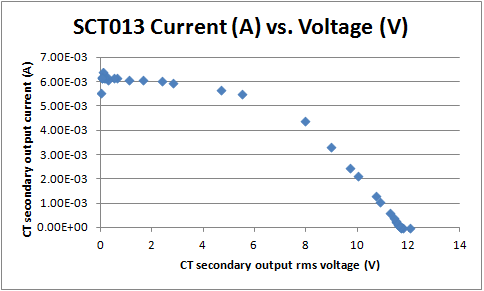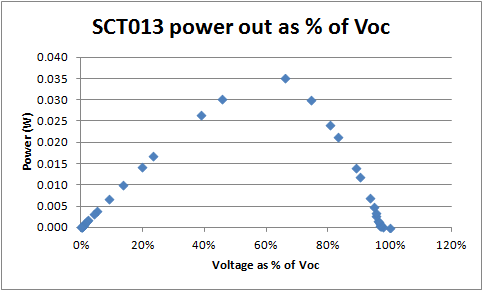-
Roadmap for low power ESP8266
04/22/2016 at 15:32 • 2 commentsI came across a neat how to on reducing the sleep power of the ESP8266. I haven't read it in any great detail yet, but I plan to look into it to see if there are any concepts I hadn't yet thought of:
https://www.hackster.io/fablabeu/esp8266-thing-by-sparkfun-982bc6
-
Down to 34 hours charge time
04/07/2016 at 03:26 • 0 commentsI'm working on optimizing the charge time. I was able to charge the 3F supercap from 2.924 V to 3.002 V in 80 minutes with a 60 W load. By a very rough linear approximation (which I know isn't accurate, but it's easy and it's not off by that much given how early this project is in its development), this would charge from 3.0 to 5.0 V in about 34 hours. This is down from the previous estimate of 100 hours.
There are still some surprising things going on. I still dont't have a proper rectifier running - I'm just using one diode and half wave rectifying. That's a lot of energy I'm throwing away. It's also a silicon diode instead of a Schottky. For some reason, the Schottky diode I bought is dropping the voltage to 0. I'll have to check that out. I have some really crazy TI "diodes" that only drop something like 26 mV, and I plan to try them soon. It would be great to make a bridge of these and to keep all the power I can.
-
SCT013 maximum power point
03/31/2016 at 02:25 • 0 commentsI ran a space heater through the current transformer primary today to get a strong secondary voltage, and I varied the resistance across the secondary to develop a VI curve so I could find the maximum power point. I solved for current and obtained the following graph:
![]()
Plotted in terms of power as a percentage of the open circuit voltage, I get this graph:
![]()
It shows me that the power harvesting hits a maximum at about 66% of the open circuit voltage. Previously, I had the harvesting circuit set to a voltage of 80% of the open circuit voltage. I should be able to obtain 0.035 W at 66% of Voc as opposed to the 0.024 W I obtained at 80% of the Voc. This should yield an efficiency improvement of about 46%. I was hoping for a doubling in one of my previous logs, but I will settle for a 46% improvement if I can actually achieve that at the output of the energy harvesting circuit.
-
Charging the supercap
03/23/2016 at 13:15 • 0 commentsI removed the built-in burden resistors from my split core current transformer (CT). This eliminates the power dissipation of that resistor and allows me to harvest as much as possible from the transformer. I was able to charge 4.5 F of supercaps from 2.9 V to 4.9 V in about one hour using a 1300 W space heater (~11 A current in the primary). This means I could charge 3 F in about 40 minutes and get about 5-6 Wi-Fi transmissions out. It looks promising.
There is one big caveat so far. I want to get one report an hour with 0.5 A in the primary (equivalent to one 60 W bulb on the circuit). I did try to charge 3 F with 0.5 A in the primary and it looked like it was going to take about 100 hours. That's not a huge surprise. The energy harvesting circuit is pretty inefficient down at the low secondary current levels. Plus, I had nothing optimized. Finally, the current transformer is not really intended for harvesting, so the turns ratio is a bit off. I do have plans to try to fix these though. A factor of 100 looks bad, but in my experience it isn't necessarily that bad.
First, I'm going to characterize the current transformer I do have. The BQ25504 has a maximum power point (MPP) setting where you set the operating voltage to be a fraction of the open circuit voltage. This is essential to get solar cells operating at their MPP. I will also use it for the current transformer. It is probably operating too close to the short circuit current, and I need to find the MPP. I will generate the IV curve by varying the burden resistance on the CT secondary to find this point. Then I will tune the resistor network on the BQ25504 to hit exactly that maximum power point. I might be able to get a factor of 2 out of this tuning, if I'm lucky. At some point, I will almost certainly get a different and more efficient current transformer that is more optimized to the task at hand.
Another thing I need to do is look at my rectification. Right now, I'm just running the CT secondary through a single diode because the diodes I had on hand dropped the voltage too much when I tried to rectify the CT secondary with a full bridge. I didn't even have a smoothing capacitor There was almost nothing left at the output of the bridge for the charging circuit. If I can get the CT output voltage a bit higher by operating closer to the MPP of the CT, I am hopeful a bridge will work, and that will probably get me a factor of 2. I'll also use Schottky diodes for their lower voltage drop.
Finally, I may have to drop the BQ25504 and look at the Linear Technologies line of harvesters. They are specified to harvest all the way down to 20 mV, whereas TI needs 330 mV to cold start the harvesting. It could just be a difference in how these are specified, but it's something I have to look into. I'm not sure what kind of efficiency improvement I can get out of this. That's the point of the testing.
The other thing I'll need to get clever about is optimizing the Wi-Fi power consumption. I have done no work at all there right now. I'm just running a webserver that autorefreshes periodically. I might be able to get a factor of 10 improvement out of the Wi-Fi by optimizing power use and possibly by selecting a different radio. The ESP8266 is just a good easy one to start with.
-
Running ESP8266 from 4.5F capacitance
03/19/2016 at 18:24 • 0 commentsI managed to get the ESP8266 to run a webserver for 90 seconds off 4.5F of supercaps. It's kind of fun to charge them, because I"m using my BooSTick. Now that I have a bunch of them around, I find myself using them all the time. You can check that project out by clicking here.
![]()
So now the question is, how fast can I charge several farads of capacitance off a current transformer? That's the next step.
-
Harvesting energy
03/18/2016 at 16:23 • 0 commentsI bought a couple current transformers and TI's BQ25504 energy harvesting kit. I was able to charge a 1.5F supercap with a space heater. It took quite a while (tens of minutes) because the current transformers were actually rated for 20 kilohertz, and didn't seem very efficient at 60 Hz. I plan to remove the ballast resistor from a split core transformer like the one pictured and I will try to harvest the higher voltage available from that circuit.
 CaptMcAllister
CaptMcAllister

